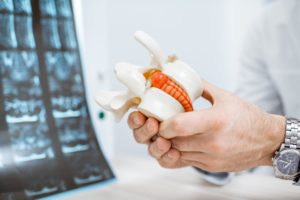When you are faced with the possibility of hernia mesh surgery, you want to be as informed as possible. Below, I’ve listed some FAQs to help you better understand what a hernia is, how a hernia mesh works, and much more.

What is a hernia?
A hernia occurs when part of an organ or a portion of fatty tissue squeezes through a weak spot in a surrounding muscle or connective tissue called fascia. The most common types of hernia are:
- Inguinal (inner groin)
- Incisional (the result of an incision)
- Femoral (outer groin)
- Umbilical (belly button)
- Hiatal (upper stomach)
In an inguinal hernia, the intestine or the bladder protrudes through the abdominal wall or into the inguinal canal in the groin. About 96% of all groin hernias are inguinal, and most occur in men because of a natural weakness in this area.
In an incisional hernia, the intestine pushes through the abdominal wall at the site of previous abdominal surgery. This type is most common in elderly or overweight people who are inactive after abdominal surgery.
A femoral hernia occurs when the intestine enters the canal carrying the femoral artery into the upper thigh. Femoral hernias are most common in women, especially those who are pregnant or obese.
In an umbilical hernia, part of the small intestine passes through the abdominal wall near the navel. Common in newborns, it also commonly afflicts obese women or those who have had many children.
A hiatal hernia happens when the upper stomach squeezes through the hiatus, an opening in the diaphragm through which the esophagus passes.
What causes a hernia?
All hernias are caused by two factors: pressure and an opening or weakness in the muscle or fascia. This pressure pushes an organ or tissue through the opening or weak spot. Sometimes people are born with this muscle weakness. Most often, it occurs later in life.
Anything that causes an increase in pressure in the abdomen can cause a hernia, including:
- Lifting heavy objects without stabilizing the abdominal muscles
- Diarrhea or constipation
- Persistent coughing or sneezing
- Obesity
- Poor nutrition
- Smoking
What is a hernia mesh?
Mesh was first introduced to the medical community in 1891 to repair hernia tears or bulges. This surgical mesh is a medical device that supports damaged tissue around hernias as it heals. Surgeons place the mesh across the area surrounding the hernia, attaching it with stitches, staples, or glue.
Hernia repair via surgical intervention is the most common procedure performed in the world. The hernia mesh is the most common corrective measure in relieving the pain, discomfort, and physical issues related to the hernia.

Why have there been lawsuits about hernia mesh?
Hernia mesh manufacturers have recalled more than 211,000 units of hernia mesh from 2005 to February 2019. Complications from recalled mesh devices include mesh failure, punctured organs, hernia recurrence, and others. Some recalls led injured patients to file lawsuits against mesh manufacturers. The FDA has classified these recalls as Class 2, which means the damage caused by the defective medical device may not cause fatal injury.
The mesh, composed of polypropylene compound, has been known to cause the following complications:
- Adhesions
- Bowel fistulas
- Punctured organs
- Device migration
- Bowel obstruction
Removal of the defective mesh via further surgical intervention is complex, especially since the mesh often adheres or becomes part of another organ tissue.
I’ve had hernia mesh surgery – now what?
If you have had a hernia mesh operation, and believe you are suffering as a result of it, click here to find out what symptoms to look for, and which mesh devices are being recalled. Allen & Allen understands the issues surrounding hernia mesh complications and is here to help provide information, and guidance on the next steps.





